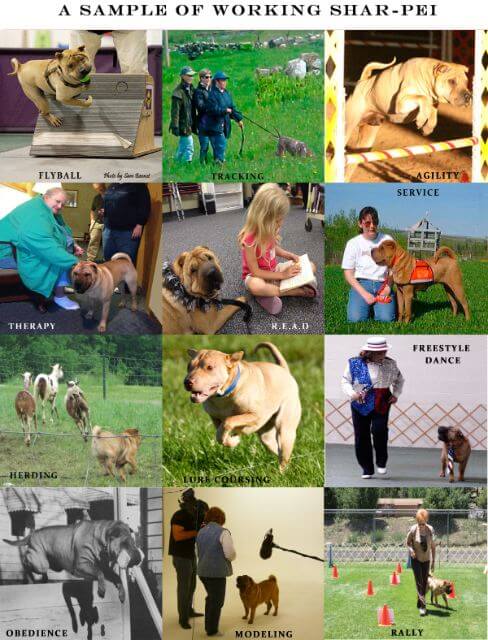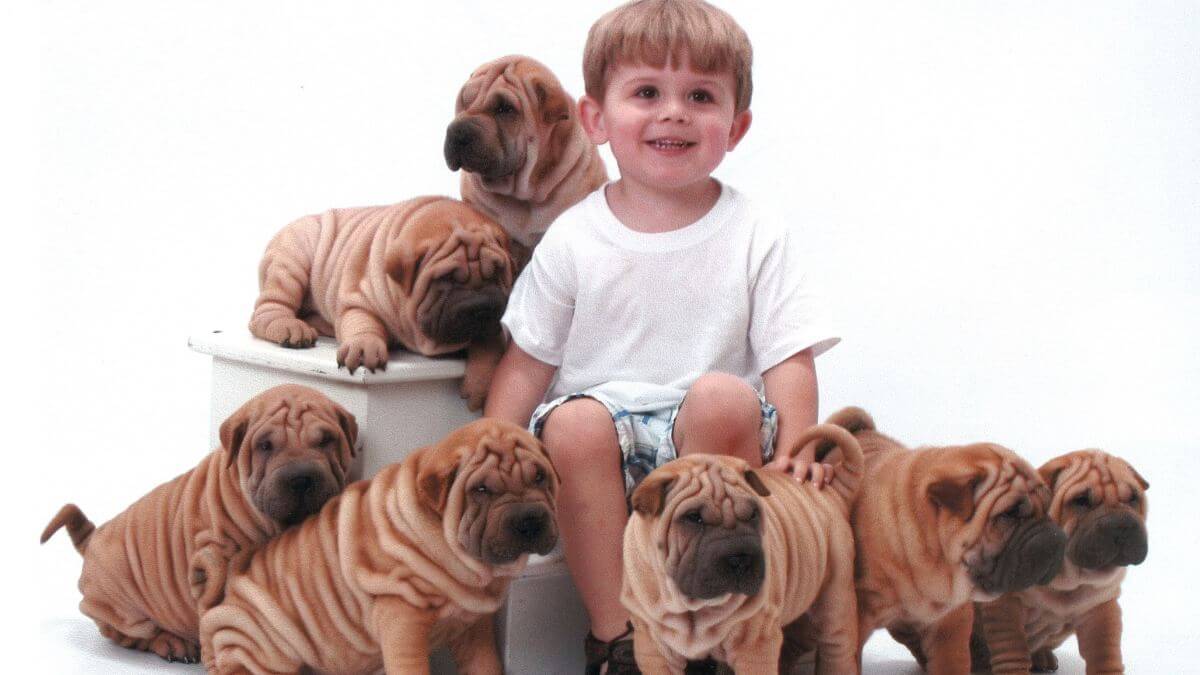This article was originally published in Showsight Magazine, January 2014 issue.
Getting to Know the Chinese Shar-Pei
The Chinese Shar-Pei originated in the southern regions of China and truly is an ancient breed. There is evidence that they existed as early as 204 AD during the Han dynasty. Farmers used them for herding, hunting, companionship, and even dog fighting. They have been referred to in the past as the Chinese Fighting Dog. That name is really a misnomer as they don’t really make good fighting dogs. The farmers thought that since they had such loose skin, it would give them an advantage over their opponents because they could still turn and fight with all that skin. Over time they learned that Shar-Pei are not good fighters, and that when they get a tear in their skin, infection can travel under the skin and multiply quickly. Around 1947 the Chinese government made the decision to discourage dog ownership by placing a tax on it. Many people could not afford the tax so they took their dogs to Hong Kong where there was no tax.
The dog population in Hong Kong began to swell. With so many dogs running the streets there was a worry that the pure breed dogs lines would disappear. Serious dog breeders in Hong Kong began shipping the best examples of Shar-Pei to the United States so the breed could be preserved. The first Shar-Pei began arriving in the United States in 1966. There were several articles written about saving the rare breed dogs, but the most famous plea to save the Shar-Pei came from Matgo Law. In 1973 he pleaded with breeders in the United States to please help save the Chinese Shar-Pei from extinction. Around that time, the Chinese Shar-Pei was considered one of the rarest breeds. If it had not been for the dedication of the breeders in Hong Kong to do what they could to save the breed, it might be that none of us would have the opportunity to see or own one. We must give them credit for seeing that this unique breed was saved and promoted.
After the first Shar-Pei came to America, it soon became evident that there needed to be some kind of organization for registering the breed. On April 24, 1974, the first organizational meeting of the Chinese Shar-Pei Club of America was held in Oregon. It was decided to change the name of the breed from the Chinese Fighting Dog to the Chinese Shar-Pei because of the negative publicity concerning dog fighting in this country. They also wrote a standard and established a registry for the breed. Since the breed was so rare, they were often shown on television and in the newspapers because of the uniqueness of the wrinkly skin. As they became better known, their popularity soared as well. They have been featured in many commercials having to do with ironing, wrinkles, washers, and dryers. They are no longer considered to be a rare breed. Most Shar-Pei owners feel that our breed has advantages over other breeds, and that they are like potato chips – you can’t have just one. Their wrinkles are just one of the most unique things about them.
The wrinkles are clearly evident when you look at the dog. Some people have been misled to believe that the wrinkles cause skin issues, but that is not true. You should be aware that the wrinkles around the face sometimes can block their view. It is important to approach a Shar-Pei directly from the front so that they can see you. You should also know that most dogs will get less wrinkling as they grow up. Puppies do outgrow their wrinkles. There are two acceptable coat types for Shar-Pei. One is the horse-coat and the other is the brush-coat. The horse-coat has harsh short hair that can be prickly. This unique hair on the horse-coat is where they got their name. Shar-Pei means sandy coat in Chinese.
The coat is supposed to be harsh like sand. These were the original Shar-Pei. The other acceptable coat, the “brush coat,” while not as short as the “horse coat,” can be up to one inch in length at the withers. It should also have a harsh texture. Another of the unique features of our breed is their natural instinct to keep themselves and their living area clean. Most puppies will housebreak themselves by 8 weeks of age. They don’t like soiling the area that they live in. Many go to the furthermost corner of the yard to do their business. Often when you get a new puppy, it takes them a few days to get used to the new home, but after 3-4 days of adjustment, they should be asking you to go outside at the correct door.

They make great family dogs but you should understand that they are guard dogs. They are 100% devoted to their families and live to be with the family members and to protect them. I have seen the hair on a Shar-Pei stand on end when a stranger got out of a car to ask “his” kids playing in the yard where someone lived. They become on full alert if they sense that someone is up to no good. A lady used to take her Shar-Pei with her to make her bank deposits at the drop off box at night. One night her dog started barking like crazy as she was pulling up to the drive-thru. Next thing she knows, the dog has jumped out of the car and is attacking something in the bushes. There was a robber with a gun that was waiting to rob her. They have an uncanny sense of knowing when things are not right. Most of the breed love children and naturally become their guardian and protectors. This breed does not do well being left alone all day and night. They require human companionship to thrive. You can be sure that as soon as you leave the house, they are waiting and alert for your return. Shar-Pei are full of energy as puppies, but as they grow up and mature they settle down to be a pretty calm dog. If you are looking for a lap dog, I’d advise you to look at another breed. Even though this breed is extremely devoted to their family, they require a little bit of separation or independence from the owner as well. They may sit in your lap for a short time just to please you but they would much rather be at your feet.
They often like to sleep where they have the best view of all the activities in the house. If everyone is settled in and busy in the den, they are happy to stay in the den to watch over the family. However, if a member is away from the house, then they like to sleep and rest where they can keep a watch over the people in the house as well and watch the doors for the arrival of those that are not there. They are vigilant in watching over their families. Shar-Pei can be quick to learn but they also are very independent. Owners need to let them know who the boss is early on. If the owner doesn’t establish themselves in the leadership role, then the Shar-Pei surely will. They are very trainable but you should also expect that from time to time they may also be stubborn as well. They do well in obedience, rally, and agility. They also make great therapy and R.E.A.D dogs. All puppies benefit with early socialization and puppy kindergarten classes as well as obedience classes. There are some Shar-Pei that do lure coursing, tracking, herding, flyball, and canine freestyle dance. As you can see they can participate in a variety of things. You may have seen them in commercials as well.
They are often used in commercials and advertising because of the ease of working with them. Shar-Pei come in a variety of colors including dilutes. Almost any solid color is acceptable as well as sable. Several different colors of puppies can be born in the same litter as well as both coat types. They should have a solid black tongue and mouth including the gums, flew, and roof. In the case of dilutes, those areas in the mouth will be a lighter lavender color. Some other unique features to the look of the breed are the triangular-shaped ears pointing towards the eyes, a tail that curves over the back, and the dip in the topline just behind the withers. Just a word of caution when buying a Shar-Pei—do not fall for the scams of paying an exorbitant price for a “rare color.”
There is no such thing as a rare color. Although Shar-Pei don’t require much in the area of grooming, they do need an occasional bath. They also need their nails trimmed and their ears cleaned weekly. The breed sheds about twice a year with the changes of the seasons. In our breed we call that “blowing their coat.” Other than that, they are a wash-and-wear breed. Shar-Pei are great family dogs and should work out in most families. Once people have owned their first one, they usually never get any other breed. If you would like more information about our breed you can find it on our website at: www.cspca.com.











